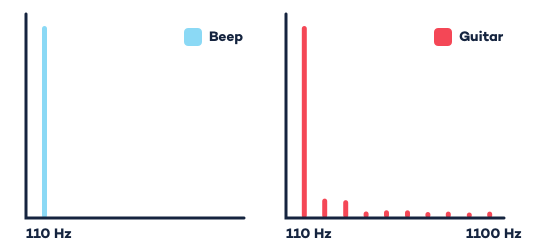Build Your Skills
Learn music theory Train your ears Track your tempoRead Now
Get the Newsletter
Categories
- | BeatMirror (10)
- | HearEQ (11)
- | Waay (23)
- | WaayFinder (1)
- Audio (16)
- For musicians (34)
- Guitar (2)
- Music theory (15)
- News (43)
- Startup stories (2)
- Tutorial (4)
Keep in Touch
About Ten Kettles
We love music, we love learning, and we love building brand new things. We are Ten Kettles.
Read more >-
October 31, 2021
Everything is Beeps
In the past two articles, we looked at the journey of a note through the air and into your ear. We came to understand how the wobbling of a guitar string ends up as a sound in your brain—and it’s remarkable.
But our example was just a simple note. In fact, it was the simplest note there is, basically just a beep:
As you play that beep, your speakers wobble exactly 110 times per second, so we’d say that the beep has a frequency of 110 Hertz (or “Hz”). Each time a speaker wobbles, it collides into the neighbouring air molecules. Just like when a stone is thrown in a pond, ripples of air molecules then spread out from the speaker—and eventually reach your ear.
When those ripples—those waves—reach your ear, they encounter a whole bunch of “frequency detectors.” These detectors are little hairs that wiggle only in response to particular frequencies. When the 110 Hz beep enters our ear, the hairs in charge of “110 Hz” start wiggling. Those hairs are attached to special cells that alert our brain that a sound has arrived. And ta-da, we hear the beep!
But real sound isn’t just beeps… or is it?
Unpacking Sound
Let’s listen to another note. I recorded this one from an acoustic guitar.
Now listen to the beep again.
Before we go on, go back and forth between the last two audio samples. Try and hear what exactly is different between the two. What makes the acoustic guitar sound different from the beep?
Notes are funny things. On one hand, both the beep and the guitar sample wobble the air at the same frequency: 110 times per second. That’s why if you hum along to one, and then hum along to the other, you’ll find you hummed the exact same thing. But they still sound so different… why is that?
Well, the guitar sound isn’t just 110 Hz. The guitar string also vibrates at double that frequency (220 Hz), triple that frequency (330 Hz), and so on. These frequencies are very special and we call them harmonics.
That first harmonic tells you what note you’re listening to: 110 Hz is an A, 131 Hz is a C, etc. It plays a fundamental role, and so we call it the “fundamental frequency.”
The other harmonics play an important role too: they tell us how the note sounds. If our sound has a strong second and third harmonic (220 Hz, 330 Hz), it will sound one way; if instead it has a strong fifth harmonic, it’ll sound quite different.
Let’s look at how much the air wobbles for each harmonic in the beep and guitar example above:

The beep is just the 110 Hz—the fundamental frequency. The acoustic guitar is very different: it has harmonics all the way up to 1100 Hz and higher!
Putting It Back Together
The word “harmonic” comes from an Ancient Greek word meaning “I fit together,” which perfectly describes harmonics. Each of the harmonics of our acoustic guitar is just a single frequency—a beep—but they all fit together to make the rich sound we hear.
Let’s hear this in action. We’re going to recreate the acoustic guitar sound just by adding up beeps. Ready? We’ll start with the fundamental frequency (110 Hz), but we’ll fade it out for a better comparison with the guitar sound. Here’s what that sounds like:
Alright, now we’re going to add in more and more harmonics and hear how they sound. We’ll start with just the first five harmonics. From the graph above, we see they’re much quieter than the fundamental frequency, so the effect will be subtle. Let’s take a listen:
It sounds a bit different, but does it sound like an acoustic guitar yet? Not really. Let’s continue. Here are the first ten harmonics…
Now the first twenty harmonics…
And finally let’s hear all of them (196 total):
That sounds pretty good! And remember this “acoustic guitar” is just a bunch of beeps—our harmonics—added together. These harmonics literally “fit together” to make our acoustic guitar sound!
Awesome. Now before we wrap up, you may be thinking, “Yeah, that sounds almost the same! But why doesn’t it sound exactly the same?” That’s a really good question. Our harmonics define, in a very large part, how an instrument sounds. But there are other frequencies in there too. Frequencies related to the room the guitar was recorded in, the characteristics of the wood, the way the guitar was recorded, and so on.
Back To the Ear
What separates one musical sound from another is more than just the note name. It’s the sonic “colour” of the instrument itself. And a large part of that colour comes down to the harmonics. Our acoustic guitar has harmonics that sound one way, and a piano has harmonics that sound a different way.
As a note is played, the fundamental frequency and harmonics ring out, sending ripples through the air molecules until they reach your ear. Those ripples are made up of many different frequencies, and each of those frequencies excites different hair cells in the ear, sending a variety of beeps into the brain.
The brain then does something amazing. It takes all those different beeps and pulls them back together, “playing” the synthesized sound to our brain—and giving us music.
Want to learn more? Check out the other articles in this series: Nature of a Note and Nature of Hearing. Want to train your ears to really hear these different frequencies? Get hearEQ today.



Comments